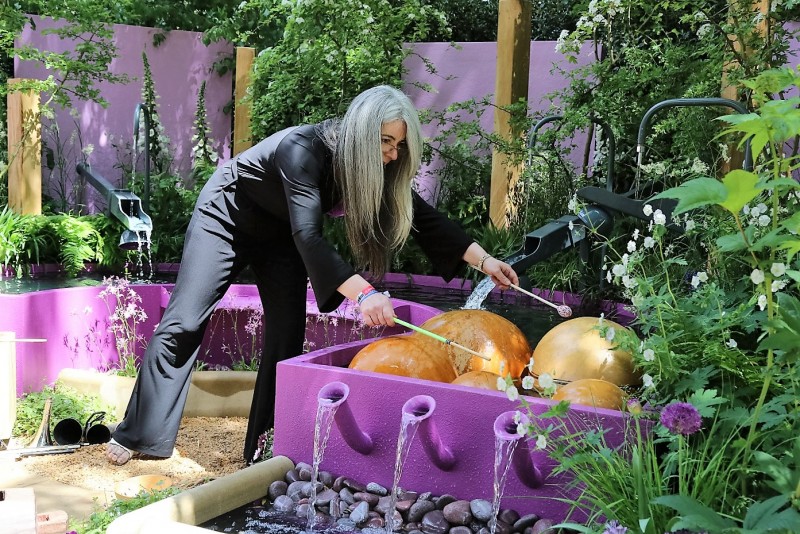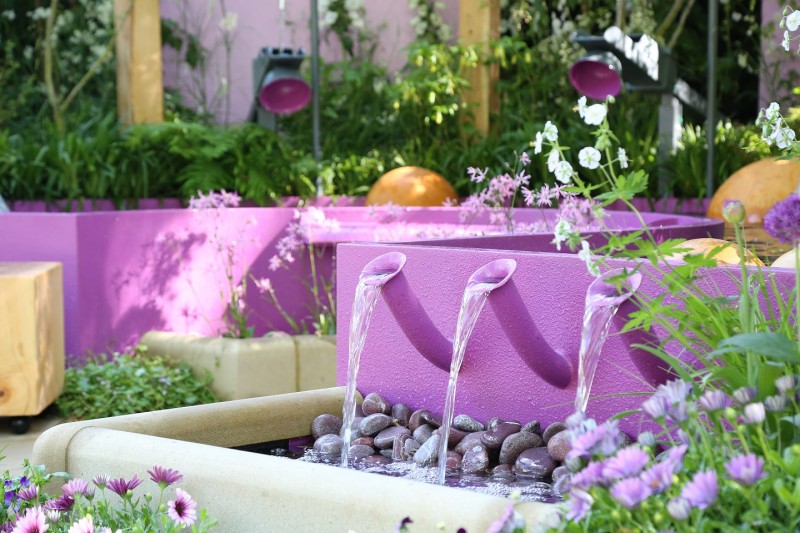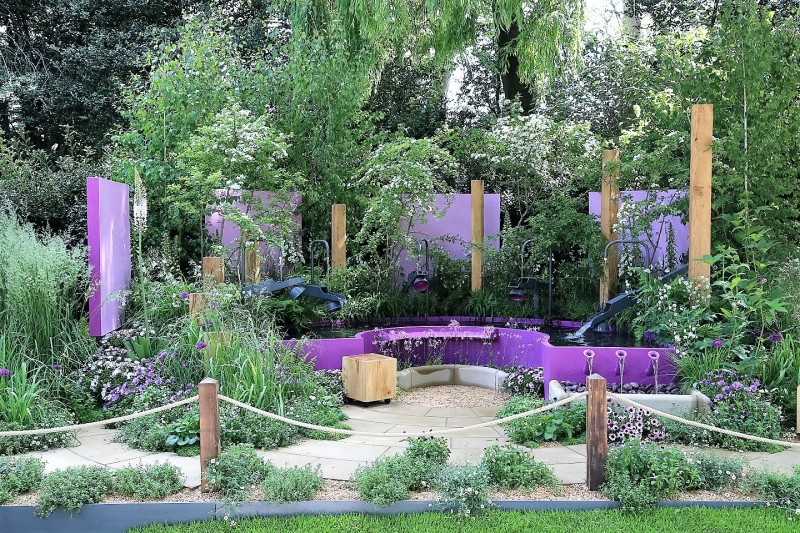Symphonic Gardens founder Peter Eustance talks about his love of music combined with garden design, and collaborating with Dame Evelyn Glennie.
Why did you start experimenting with acoustic landscapes?
I have always been struck by the creative correlation between landscape design and music, hence the name of our practice Symphonic Gardens.
There are parallels between music and garden making at every level: the composition process, coordination of multiple components, performance, the relationship and influence of site and seasonality, the experience and response of the audience. For every term and concept used in the world of music there is a corresponding application in landscape design; movements, passages, theme, anticipation, space, dynamic, texture, tempo, colour, ornamentation etc. One of the critical dimensions music and gardens share more than any other creative form is their relationship and interdependence with time. I would like to think that I design gardens, landscape and spaces with at least a subconscious sense of musicality.
The concept of the ‘water marimba’ took shape whilst I was installing a landscape sculpture with my daughter Phoebe at the 2014 Festival des Hortillonages on a tiny island on the River Somme in Amiens, France. We got up before dawn to photograph her sculpture, as the early mists were rising from the water surface. It was a magical moment. The light and tranquility were stunning and the gentle a-rhythmic sounds of water lapping at the edge of the mirror-like surface, the waking water fowl, the odd splash of a fish breaking the surface, accentuated the sense of stillness, peace and harmony.
Are you musical?
I am passionate about music and its value in society. I am sure I would be a great musician if my hands and fingers were better connected to my brain. I can hear the intensity of emotion and the beauty of the piece when I sit down at the piano, but it’s locked in my head and never emanates from the instrument.
I was a chorister at 6 years old for 10-12 years at my local church. Looking like an angel but I fear not sounding like one. I had the privilege of being head chorister for one night only at St Paul’s Cathedral, as we were invited to stand in for St Paul’s choir as they went on holiday. The variation and relationship between the architectural spaces and the acoustic characteristic made an impact on me. The congregation in stone clad voids of cathedrals and church spaces.
Tell us about your collaboration with Dame Evelyn Glennie.
I was approached by disability charity Papworth Trust to create a garden at Chelsea this year. As we discussed the brief, I was impressed by their positive ethos and particularly interested when they informed me that they had an association with the world famous percussion soloist Dame Evelyn Glennie, who is profoundly deaf. Having admired Evelyn’s incredible achievements ever since seeing her on television in 1986, this was an exciting prospect. The water marimba idea, having been dormant for 18 months suddenly seemed very appropriate.
My design for the central water feature developed in to a semi-circular sculptural form that would encapsulate the visible and the audible consequences of the simple movement of water. I wanted to relate every aspect of the garden to the physics and nature of sound; concentric radial sonic wave patterns, layout resembling an orchestra embracing the audience, acoustic reflector panels & structures that might be suggestive of a recording studio, planting for a naturalistic backdrop while incorporating plants that demonstrate musicality in nature; patterns, texture, rhythmic growth.
On presenting the design concept to Dame Evelyn, her immediate reaction was ‘it’s an ear’. A great start!
We were both committed to creating a believable audible layer to the garden. Another key purpose of the garden was to facilitate and encourage musical interaction with people of all abilities. I invited the sonic arts students of Brunel University music department to join us in the project and we held a series of practice sessions exploring the potential of the water feature, enabling Evelyn to introduce the students to a new way to appreciate sound, to ‘touch the sound’. I thought the students would be asked to record her instruments to give the garden a backdrop audio-layer, but the first sound Evelyn asked the students to respond to was the colour, texture and diversity of a handful of gravel and dry straw being rubbed on a sandstone floor. Raw musicality!
The resulting show garden at Chelsea was a great success. The further dimension of live improvised performances by Evelyn demonstrated the interactive potential of the project, with mesmerising effect.

Are there other composers you’d like to work with?
The natural landscape is its own composer. Inviting artists to create alongside it is an appealing idea.
Arvo Pärt and Anna Meredith are two that spring to mind.
The essence of the partnership between artist and landscape would have to be one of free improvisation. Dame Evelyn is a genius at this. There are a number of additional creative art-forms that I think would work incredibly well, particularly contemporary dance forms.
Will there be more water marimbas?
Definitely. There is so much to explore and develop but the concept will not become divorced from the essential idea of the landscape creating the musical setting, sounds, tempo, texture, pattern, timbre; inviting us to improvise alongside. So many visitors at Chelsea were captivated and moved, occasionally to tears, by the ethereal connection between nature, sound and vision. Many were keen to discuss its therapeutic potential; it seemed to provoke a deep, primeval response. I look forward to exploring a range of applications in the community.
Three artists in three words.
Ludwig van Beethoven; tortured, perfection, immense
JMW Turner; abstract light, natural, pre-modernism
Billie Holliday; unique, abused, honest
and a fourth, Phoebe Eustance; opened my eyes.
Water is a big part of your creative life. Which water features are you drawn to?
Water provides the driving force and fundamental essence of life. It’s presence in the natural landscape, in whatever form, is stimulating and profound. There is nothing as relaxing, invigorating and cleansing as walking alongside natural water; river, stream, lake, seashore. The inclusion of water in the created landscape should be reverential. My preference is to encourage the presence of water with a sense of minimalism and proportional scale, to capture the essence of its properties and enhance the experience of the space.
The beautiful shapes created by grass banks and sculpted reflective canals at Studley Royal Park water gardens. The simple, functional pools (impluvia) set in the centre of ancient Roman and Greek courtyards designed to catch the rain channeled from the roofs. The importance of water is so evident in places such as Pompeii. Similarly the rills, canals and simple cascades at Alhambra and other Islamic landscapes.
I admire the work of William Pye. His water sculptures are simple and beautiful.

What is the biggest challenge when working with water in gardens?
Simplicity. Subtlety. Not attempting to force a natural feature in an unnatural setting. Understanding the biological equilibrium of natural water systems and how to circumvent this with gentle, cleansing methods.
Your favourite garden of the world.
Portcullis Lodge.
A garden nestling in the rugged geological fissures of the North Yorkshire moors, where my grandparents retired to in the late 1960s. Visited perhaps each year as a boy during holidays. Certainly not a designed garden but my grandfather’s pride and joy. It was the answer to ‘are we here yet? (three and a half hours’ up the great north road). A little square courtyard with 1970s pink and buff interlocking concrete slabs, a central rose bed, a Viburnum davidii in one corner, iron railings on one side set above the garden, cows in the field reaching through to eat his plants. A tunnel between the garage and cottage with a corrugated Perspex roof filled with the scent and colour of his prize climbing pelargoniums, a rose garden on a bank at the front of the house, a vegetable garden and orchard across the drive; all fed by the sheep droppings my brother and I had to collect having been left on a roadside verge on the moors whilst he went to Rotary meetings, then stewed in a tank of water (the droppings). Views across the valley and on to Whitby, a gateway to freedom, adventure, the moors, the river Esk; Memories.
Your favourite garden plant.
Hazel.
The garden you visit the most.
The natural landscape. North Yorkshire Moors, North Wales, the north Norfolk Coast line. My wife and I had a wonderful trek in the Colombian Andes cloud forests last winter visiting our daughter Holly.
The Walled Garden, Grimsthorpe Castle, our studio site.
What’s happening in 2017?
Designs for a number of interesting landscape schemes installed in the coming months, and starting new projects.
Continuing to explore, evolve and promote the concept of the interactive acoustic landscape, alongside our water features.
To establish a gallery of landscape features and installations in the walled garden at Grimsthorpe Castle.

Interview published October 2016.
